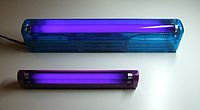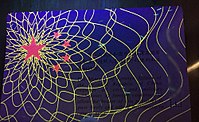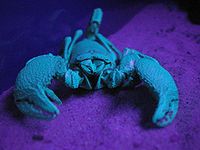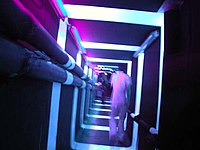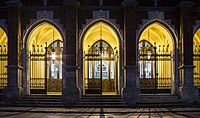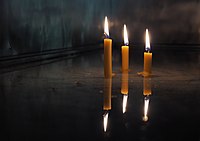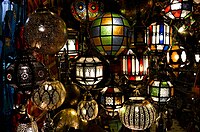Blacklight
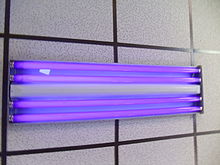
A blacklight, also called a UV-A light, Wood's lamp, or ultraviolet light, is a
Blacklight sources may be specially designed
Although many other types of lamp emit ultraviolet light with visible light, black lights are essential when UV-A light without visible light is needed, particularly in observing
Medical hazard
UV-A presents a potential hazard when eyes and skin are exposed, especially to high power sources. According to the World Health Organization, UV-A is responsible for the initial tanning of skin and it contributes to skin ageing and wrinkling. UV-A may also contribute to the progression of skin cancers.[8] Additionally, UV-A can have negative effects on eyes in both the short-term and long-term.[9]
Types
Fluorescent
Fluorescent black light tubes are typically made in the same fashion as normal
2F
8:Eu2+
) or europium-doped strontium borate (Sr
3B
2O
6:Eu2+
) while the phosphor used to produce a peak around 350 to 353 nanometres is lead-doped barium silicate (BaSi
2O
5:Pb+
). "Blacklight blue" lamps peak at 365 nm.[12]
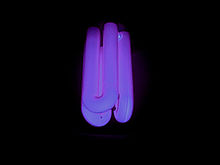
Manufacturers use different numbering systems for black light tubes. Philips uses one system which is becoming outdated (2010), while the (German) Osram system is becoming dominant outside North America. The following table lists the tubes generating blue, UVA and UVB, in order of decreasing wavelength of the most intense peak.[a] Approximate phosphor compositions, major manufacturer's type numbers and some uses are given as an overview of the types available. "Peak" position is approximated to the nearest 10 nm. "Width" is the measure between points on the shoulders of the peak that represent 50% intensity.
| Phosphor Mixture |
Peak ( nm )
|
Width ( nm )
|
Philips suffix |
Osram suffix |
U.S. Type | Typical use |
|---|---|---|---|---|---|---|
| — | 450 | 50 | — | /71 | — | hyperbilirubinaemia , polymerization
|
| SrP 2O 7:Eu |
420 | 30 | /03 | /72 | — | photochemical polymerization |
| SrB 4O 7:Eu |
370 | 20 | /08 | /73 | ("BLB") | forensics, lapidary , night clubs
|
| SrB 4O 7:Eu |
370 | 20 | — | /78 | ("BY") | [c] insect attraction, polymerization, psoriasis, tanning beds |
| BaSi 2O 5: Pb
|
350 | 40 | /09 | /79 | "BL" | [c] insect attraction, tanning beds |
| BaSi 2O 5: Pb
|
350 | 40 | /08 | — | "BLB" | forensics , night clubs
|
| SrAl 11O 18:Ce |
340 | 30 | — | — | — | photochemistry |
| MgSrAl 10O 17:Ce |
310 | 40 | — | — | — | medical applications, polymerization |

"Bug zapper" tubes
Another class of UV fluorescent bulb is designed for use in "
Incandescent

A black light may also be formed by simply using a UV filter coating such as
Mercury vapor
High power
LED
This section is missing information about how wide the spectrum is, ideally with a pic of the SPD. (December 2022) |
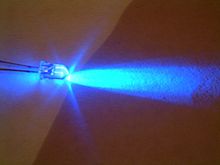
Ultraviolet light can be generated by some
Safety
Although black lights produce light in the UV range, their spectrum is mostly confined to the longwave UVA region, that is, UV radiation nearest in wavelength to visible light, with low frequency and therefore relatively low energy. While low, there is still some power of a conventional black light in the UVB range.[15] UVA is the safest of the three spectra of UV light, although high exposure to UVA has been linked to the development of skin cancer in humans. The relatively low energy of UVA light does not cause sunburn. UVA is capable of causing damage to collagen fibers, however, so it does have the potential to accelerate skin aging and cause wrinkles. UVA can also destroy vitamin A in the skin.
UVA light has been shown to cause
UV-A can have negative effects on eyes in both the short-term and long-term.[9]
Uses
Ultraviolet radiation is invisible to the human eye, but illuminating certain materials with UV radiation causes the emission of visible light, causing these substances to glow with various colors. This is called fluorescence, and has many practical uses. Black lights are required to observe fluorescence, since other types of ultraviolet lamps emit visible light which drowns out the dim fluorescent glow.
Medical applications
A Wood's lamp is a diagnostic tool used in
Fungal and bacterial infections
It is also helpful in diagnosing:
- tinea, such as Trichophyton tonsurans, do not fluoresce.[18]
- Bacterial infections[19]
- Corynebacterium minutissimum is coral red
- Pseudomonas is yellow-green
- Cutibacterium acnes, a bacterium involved in acne causation, exhibits an orange glow under a Wood's lamp.[20]
Ethylene glycol poisoning
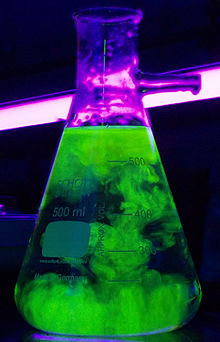
A Wood's lamp may be used to rapidly assess whether an individual is suffering from ethylene glycol poisoning as a consequence of antifreeze ingestion. Manufacturers of ethylene glycol-containing antifreezes commonly add fluorescein, which causes the patient's urine to fluoresce under Wood's lamp.[21]
Other
Wood's lamp is useful in diagnosing conditions such as tuberous sclerosis[22] and erythrasma (caused by Corynebacterium minutissimum, see above).[23] Additionally, detection of porphyria cutanea tarda can sometimes be made when urine turns pink upon illumination with Wood's lamp.[24] Wood's lamps have also been used to differentiate hypopigmentation from depigmentation such as with vitiligo. A vitiligo patient's skin will appear yellow-green or blue under the Wood's lamp.[citation needed] Its use in detecting melanoma has been reported.[25]
See also
Bili light. A type of phototherapy that uses blue light with a range of 420–470 nm, used to treat neonatal jaundice.
Security and authentication
Black light is commonly used to authenticate
Other security applications include the use of pens containing a fluorescent ink, generally with a soft tip, that can be used to "invisibly" mark items. If the objects that are so marked are subsequently stolen, a black light can be used to search for these security markings. At some amusement parks, nightclubs and at other, day-long (or night-long) events, a fluorescent mark is rubber stamped onto the wrist of a guest who can then exercise the option of leaving and being able to return again without paying another admission fee.
Biology
Fluorescent materials are also very widely used in numerous applications in molecular biology, often as "tags" which bind themselves to a substance of interest (for example, DNA), so allowing their visualization.
Thousands of moth and insect collectors all over the world use various types of black lights to attract moth and insect specimens for photography and collecting. It is one of the preferred light sources for attracting insects and moths at night. Black light can also be used to see animal excreta such as urine and vomit that is not always visible to the naked eye.
Detection of faults
Black light is used extensively in non-destructive testing. Fluorescing fluids are applied to metal structures and illuminated with a black light which allows cracks and other weaknesses in the material to be easily detected.
In addition, if a leak is suspected in a refrigerator or an air conditioning system, a UV tracer dye can be injected into the system along with the compressor lubricant oil and refrigerant mixture. The system is then run in order to circulate the dye across the piping and components and then the system is examined with a blacklight lamp. Any evidence of fluorescent dye then pinpoints the leaking part which needs replacement.
Decorative and artistic uses
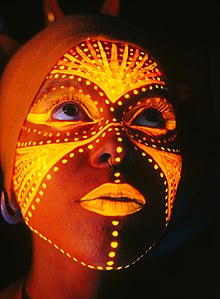
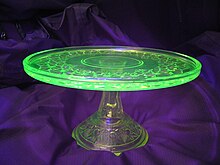
It is also used to illuminate pictures painted with fluorescent colors, particularly on black velvet, which intensifies the illusion of self-illumination. The use of such materials, often in the form of tiles viewed in a sensory room under UV light, is common in the United Kingdom for the education of students with profound and multiple learning difficulties.[26] Such fluorescence from certain textile fibers, especially those bearing optical brightener residues, can also be used for recreational effect, as seen, for example, in the opening credits of the James Bond film A View to a Kill. Black light puppetry is also performed in a black light theater.
Mineral identification
Blacklights are a common tool for
Curing resins
UV light can be used to harden particular glues, resins and inks by causing a photochemical reaction inside those substances. This process of hardening is called ‘curing’. UV curing is adaptable to printing, coating, decorating, stereolithography, and in the assembly of a variety of products and materials. In comparison to other technologies, curing with UV energy may be considered a low-temperature process, a high-speed process, and is a solventless process, as cure occurs via direct polymerization rather than by evaporation. Originally introduced in the 1960s, this technology has streamlined and increased automation in many industries in the manufacturing sector. A primary advantage of curing with ultraviolet light is the speed at which a material can be processed. Speeding up the curing or drying step in a process can reduce flaws and errors by decreasing time that an ink or coating spends wet. This can increase the quality of a finished item, and potentially allow for greater consistency. Another benefit to decreasing manufacturing time is that less space needs to be devoted to storing items which can not be used until the drying step is finished. Because UV energy has unique interactions with many different materials, UV curing allows for the creation of products with characteristics not achievable via other means. This has led to UV curing becoming fundamental in many fields of manufacturing and technology, where changes in strength, hardness, durability, chemical resistance, and many other properties are required.
Other
One of the innovations for night and all-weather flying used by the US, UK, Japan and
They may also be used to test for
Strong sources of long-wave ultraviolet light are used in
-
The security thread of a US $20 bill glows green under black light as a safeguard against counterfeiting.
-
Anti-counterfeiting design of a Chinese passport glows under black light.
-
Scorpion fluorescing under ultraviolet from a black light
-
Decorative use of black light in a nightclub
-
A common task in escape rooms is to find parts of an eye-safe blacklight torch to assemble to reveal messages in invisible ink
See also
Footnotes
- ^ a b Compiled from various Philips, Osram, and Sylvania lighting catalogues.
- ^ a b BLB fluorescent lamps tend to run with efficiencies in the 25% range, with an example being a Phillips 40W BLB T12 lamp emitting 9.8W of UVA for 39 Watts of power input.[13]
- ^ a b
calcium metasilicatethat emits a wider band with a shorter wavelength peak at about 350 nm. These two types seem to be the most commonly used. Different manufacturers offer either one or the other and sometimes both.
References
- ISBN 978-1-4398-9931-1. Archivedfrom the original on 2013-05-27.
- ISBN 978-1-4377-5581-7. Archivedfrom the original on 2013-05-26.
- ^ ISBN 978-0-08-086030-5. Archivedfrom the original on 2013-05-27.
- ^ ISBN 978-0-240-51566-3. Archivedfrom the original on 2013-05-27.
- ^ a b c d e "Black Lights". Technical information. Glow Inc. 2010. Archived from the original on November 16, 2018. Retrieved November 15, 2018.
- ^ a b Rorie, Benjamin (2011). "How Do Black Lights Work?". Blog. 1000Bulbs.com. Archived from the original on February 14, 2013. Retrieved January 16, 2013.
- (PDF) from the original on 2023-03-11. Retrieved 2023-01-15.
- ^ "Radiation: Ultraviolet (UV) radiation". World Health Organization. 9 March 2016. Archived from the original on 28 January 2021. Retrieved 15 February 2021.
- ^ a b "Ultraviolet (UV) protection". American Optometric Association.
- ^ a b "What is the difference between BL and BLB blacklights?". Specialty and Architectural Lighting. Pro Lamp Sales website. 2014. Archived from the original on 5 March 2021. Retrieved 11 December 2020.
- ^ "About Black Light" (PDF). Insect-O-Cutor. Archived (PDF) from the original on 2013-06-04.
- ^ "Osram". Photocopy and UV Emitting Phosphors / Lighting Components. Sylvania. Archived from the original on 2008-01-10 – via Archive.org.
- ^ "BLB LF Datasheet". philips.com. Phillips Lighting. 2018. F40T12/BLACKLIGHT/48. Archived from the original on 2018-08-29. Retrieved 2018-08-29.
- ^ Zaithanzauva Pachuau; Ramesh Chandra Tiwari (October–December 2008). "Ultraviolet Light- its Effects and Applications" (PDF). Science Vision. 8 (4): 128. Archived from the original (PDF) on 2015-05-06. Retrieved 2019-01-21.
- S2CID 29022446.
- ^ "ESPCR Blog". European Society for Pigment Cell Research. Archived from the original on 2011-07-26.
- ^ Zeman, Gary (2009). "Ultraviolet Radiation". Health Physics Society. Archived from the original on 2010-01-13.
- S2CID 42087839.
- ISBN 978-1-4051-6169-5. Archivedfrom the original on 27 May 2013. Retrieved 14 November 2010.
- ^ Mike Phillips (2007-09-25). "Eikone.com". Eikone.com. Archived from the original on 2012-03-06. Retrieved 2011-11-08.
- PMID 2344083.
- from the original on 2008-08-28.
- S2CID 22836457.[permanent dead link]
- ^ Le, Tao; Krause, Kendall (2008). First Aid for the Basic Sciences—General Principles. McGraw-Hill Medical.
- S2CID 31548983.
- ^ Communication Aids for Language and Learning—UV light Archived 2010-06-05 at the Wayback Machine Equipment for use in sensory rooms for students with profound and multiple learning difficulties in United Kingdom schools.
- ^ The fluorometric determination of lysergic acid diethylamide and ergonovine Archived 2015-12-25 at the Wayback Machine A fluorometer was designed to detect very small amounts of LSD and ergonovine. The instrument proved less satisfactory than the Bowman fluorometer. Both LSD and ergonovine lost their fluorescence very rapidly upon strong ultraviolet irradiation. The mechanism involved in this decrease in fluorescence is not known.
External links
- MedlinePlus Encyclopedia: Wood's lamp examination
- "U.V.C to U.V.A conversion Phosphors for Black Light sources". Sylvania. Archived from the original on 2011-07-24.
- "What Materials Glow Under a Black or Ultraviolet Light?". About.com. Archived from the originalon 2015-01-22. Retrieved 2007-07-09.
- "Database of fluorescent minerals with pictures, activators and spectra". fluomin.org.
- http://mississippientomologicalmuseum.org.msstate.edu/collecting.preparation.methods/Blacklight.traps.htm


